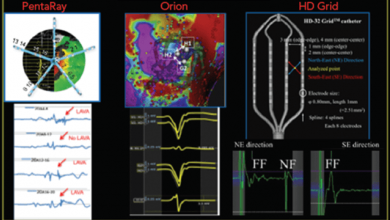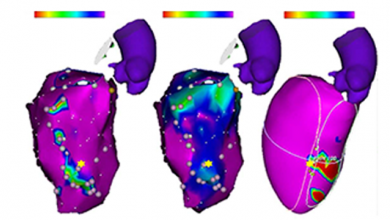Search results
Author(s):
Takumi Yamada
,
G Neal Kay
Added:
3 years ago
Idiopathic ventricular arrhythmias (IVAs) usually originate from the specific anatomical structures. For the past decade, major IVA origins from both endocardial and epicardial sites have been increasingly recognised (see Table 1).1–3 Catheter ablation of IVAs is usually safe and highly successful, but can sometimes be challenging because of the anatomical obstacles. Therefore, understanding the…
View more
Author(s):
Josef Kautzner
,
Petr Peichl
Added:
3 years ago
Ventricular fibrillation (VF) is a complex arrhythmia that leads invariably to cardiac arrest. Its mechanisms remain largely unclear. Similar to atrial fibrillation, the mother rotor hypothesis is one plausible alternative.1,2 In larger animals, some authors reported that the dominant frequency of VF could be recorded at a junction of the left ventricular posterior wall and the septum.3-6 Others…
View more
Author(s):
Abhishek Bhaskaran
,
John Fitzgerald
,
Nicholas Jackson
,
et al
Added:
3 years ago
Body Surface Electrocardiographic Mapping for Non-invasive Identification of Arrhythmic Sources
Author(s):
Ashok J Shah
,
Meleze Hocini
,
Patrizio Pascale
,
et al
Added:
3 years ago
Article
Author(s):
Riyaz Kaba
,
Omar Ahmed
,
Elijah R Behr
,
et al
Added:
1 year ago
Author(s):
David Filgueiras-Rama
,
Jose L Merino
Added:
3 years ago
Atrial fibrillation (AF) is the most common sustained arrhythmia in the clinical practice.1 The prevalence of the arrhythmia is progressively increasing in developed countries and moreover, it is expected to affect up to 12 million people only in the US by 2050.2 Antiarrhythmic drugs continue to represent the first-line of treatment in AF patients, either to restore sinus rhythm or to prevent…
View more
Author(s):
Benjamin L Freedman
,
Timothy R Maher
,
Madison Tracey
,
et al
Added:
10 months ago
Author(s):
Benjamin Berte
,
Katja Zeppenfeld
,
Roderick Tung
Added:
3 years ago
Accurate substrate characterisation is important for depicting scar-related re-entrant tachycardia to optimise ablation targets and strategies. The underlying substrate can be analysed using electrogram (EGM) characteristics, such as low voltage, local abnormal voltage activity (LAVA), evoked potentials or late potentials, conduction analysis in sinus rhythm or differential pacing, or using…
View more
Author(s):
Ling Kuo
,
Jackson J Liang
,
Saman Nazarian
,
et al
Added:
3 years ago
Catheter ablation has been increasingly used as a treatment for refractory ventricular tachycardia (VT) in patients with non-ischaemic cardiomyopathy (NICM). However, ablation outcomes tend to be quite variable because of the heterogeneity of the aetiology for the NICM and associated VT substrate in these patients.1–3 Patients with NICM can be sub-classified based on specific genotypic and…
View more
Author(s):
Vincent Umbrain
,
Christian Verborgh
,
Gian-Battista Chierchia
,
et al
Added:
3 years ago
The current option for refractory treatment for atrial fibrillation (AF) includes hybrid AF-surgery.1–2 The hybrid approach was originally a combination of mini-invasive surgical epicardial evaluation and ablation, as well as endocardial electrophysiologist (EP) catheter ablation with the intention of creating a lesion set to cure AF.3 In the search for greater efficacy with less patient…
View more
















 « First
« First